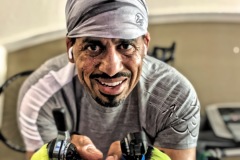I’ve learned through experience that success in endurance sports is largely a mental game. On the surface, that concept seemed straightforward. In short, my mind and body have to work together to complete an endurance event. Easy.
Wrong!
Those words simply don’t convey the magnitude of the influence of one’s mind. I, and many people that I know, believe that endurance training is predominantly about physical strength. As a consequence, we work almost entirely to increase our physical strength and stamina. Intuitively, we know that we must become stronger to race longer or faster. In my experience, the role of mental endurance is rarely discussed so we are left to figure out what to do when our minds begin to rebel in the middle of a race. When we are in the midst of suffering, should we listen to the self-doubt or the desire to quit prematurely? Staying the course when those urges are the strongest feels like a Herculean effort. Thus far, I have been unsuccessful more times than I’ve been successful in winning the battle. Clearly, to better prepare for these moments, there is a need to build “mental muscle”. After reflecting on Ironman Texas results, I feel like I’ve entered the mental muscle phase of athletic development. My base level of fitness is sufficient to execute a full Ironman, but squeezing more out of myself requires greater mental strength.
On Saturday when I looked at my training calendar, I read “two-hour zone 2” ride. It was hot outside, so I decided to ride indoors using Zwift. As I set up my bike and created the session I noticed that my power target was higher than expected. So, I assumed that Johnny has adjusted my zones. No big deal. Zone 2 is moderately-easy riding.
One hour into the ride, I felt my legs burning more than normal. Typically, when this occurs I begin to doubt my ability to sustain the effort. On this day, I shrugged and thought, it’s only zone 2, I can keep doing this. My legs are probably still a little fatigued from Ironman Texas. Keep going!
I entertained myself by watching the Ironman World Championships in St. George, UT. because seven people from our triathlon club were racing. The live coverage doesn’t show the age-group athletes until they cross the finish line, so I watched the professionals. I noticed that my intensity would increase when I saw the pro’s pushing harder. The race was a great distraction.
After completing the session, I reviewed the ride and my training plan again. Johnny had not adjusted my zones. I was actually riding in Zone 3 the whole time. Had I begun the session with that knowledge, I would have struggled more as my legs began to burn. The doubt would have gotten louder and louder until I convinced myself that I was at my limit. I’ve done it time and time again.
So what was different today?
On this day, my perception was different. I thought I was doing an easy ride. So, when I began to have to work harder, I justified it and assumed that I could continue doing it for the prescribed time. Had I read the instructions clearly, I would have known it was going to be a harder effort and begun the session doubting myself. That bit of doubt would hide in the back of my mind until I began feeling the strain on my leg muscles. At that time, it would begin whispering. Then, as time progressed, it would get louder and louder until I began finding reasons to stop early. I’m very good at acquiescing to the doubt-monster in my head.
This ride made me acutely aware of just how powerful the elimination of doubt can be. In the beginning, there were rarely any issues or reasons to question my capability. Not until I bump up against an existing limit or a perceived limit aka my “comfort zone” do I find that I have to battle with self-doubt and its incessant whispering. This session showed me that doubt is real, but not necessarily connected to reality.
Begin with the end in mind
Steven Covey
The better I become at starting with full confidence, the more likely I’ll be willing to push hard to achieve the desired outcome.














